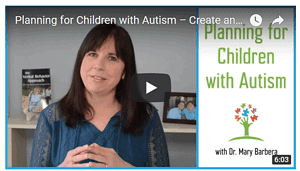Planning for children with autism is essential for a child to reach their fullest potential. Making a plan that will work at home and at school is the second most important step to start turning autism around for your clients or child, so I’m diving into the topic of planning today.
One of the biggest problems I see in the autism world are well-meaning parents and professionals simply working on the wrong things. This is caused by not assessing the whole situation and then not using that assessment to make a plan for the child, both at home and school.
Let me tell you about Brentley. Brentley’s mom, Kelsey, was driving little Brentley, who was only two and a half years old, an hour each way to an ABA clinic. He was working on colors when he was at the ABA clinic but he shouldn’t have been working on colors because Brentley was banging his head on hard surfaces up to 60 times a day. He was running into streets and into the water, requiring Kelsey to put a harness and a leash on while Brentley was out in the community. So there’s an example where the ABA staff and Kelsey were working on the wrong things and it wasn’t helping Brentley.
I also have another example of a boy who was about 10 years old when I worked with him briefly. And the staff was trying to teach him prepositions, colors, intraverbal webbing and all these more advanced language topics. But, this 10-year-old couldn’t even wash his hands independently. He also insisted on sitting on a sofa during all meals, refusing to come to the table with his parents. So here’s another example where we’re not looking at the whole picture and not making a plan based on the child’s strengths, needs, age, and as well as family priorities.
In all situations, I recommend a thorough assessment, but it doesn’t have to be super thorough on day one. In fact, I created a one-page assessment form several years ago, that can be completed in about five or ten minutes. So after the assessment of the whole situation is done, we want to look at creating a plan. That plan needs to be based on the child’s strengths and needs, and based on the assessment that you just completed. It also needs to take into account the child’s age and family priorities.
It’s common to have a lot of issues that you want to address. You might have a strength column on the planning form that’s very short and the need column is very long. In Brentley’s situation, if potty training was a need, but he’s only two and a half or three at that point, if he’s banging his head on hard surfaces, if he’s running into the street, has no safety awareness, has no ability to come to a table and to request things, then working on potty training is not a need to prioritize right this second. We can’t tackle all the needs at the same time. This is where we have to really work with the family and the professionals to come up with a plan that is right for the child.
If I were teaching you how to fly a plane or play the guitar, it would take months to master even the most basic concepts. So it’s best to start at ground zero, as a team, the first note you would play on the guitar or the first main panel with just a few buttons. We need to go back to more basic, very simple tasks before we get to harder tasks. You can update the assessment and planning forms every few months. This will allow you to go back and see how much progress your child or client makes, and see how their strengths and needs change over time.
To get the free assessment form and planning form, you can download my free guide and join me on my mission to turn autism around for two million by 2020 by going to marybarbera.com/join — there you can get the free guide and get started today. And even if you are a seasoned professional, this guide will help you look at things possibly a little bit differently and have some handy resources that can help you and the families that you work with start turning things around today. So don’t forget, download the free guide at marybarbera.com/join and I’ll see you next week.







